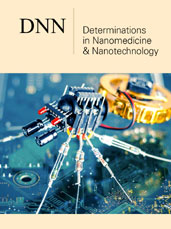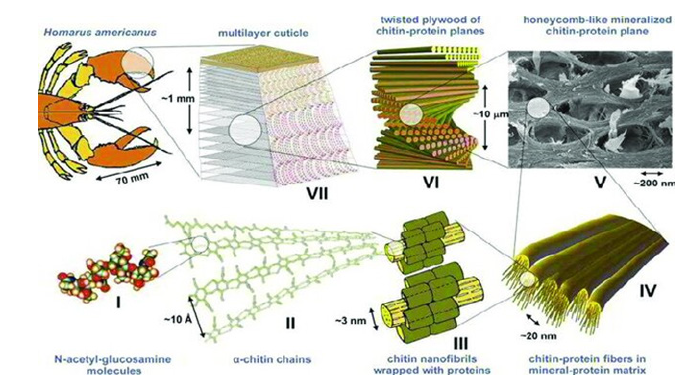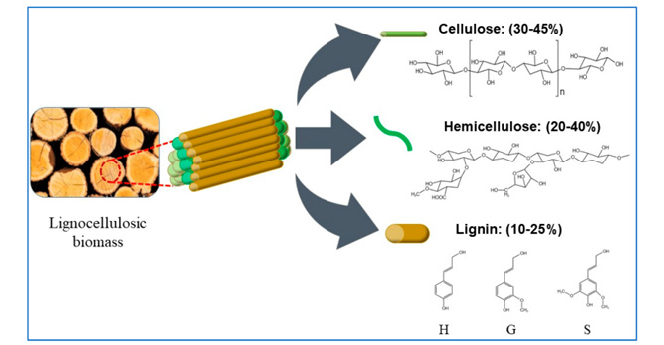- Submissions

Full Text
Determinations in Nanomedicine & Nanotechnology
Chitin-Lignin Complex as New Green Tissue-Carrier for Innovative Pro- Aging Cosme-Nutraceuticals
Pierfrancesco Morganti1,2*
1China Medical University, China
2Director of R&D Center, Nanotechnology Unit, Academy of History of Healthcare Art, Italy
*Corresponding author:Pierfrancesco Morganti, China Medical University, Shenyang, China and Director of R&D Center, Nanotechnology Unit, Academy of History of Healthcare Art, Rome, Italy
Submission: July 16, 2025;Published: September 18, 2025

ISSN: 2832-4439 Volume3 Issue 4
The Chitin-Lignin (CL) complexes seem to represent new biodegradable and active carriers useful for making innovative drugs, diet supplements and Cosmetics. CL, made by two natural biopolymers, may be entrapped into the fibers of tissues that realized by the electrospinning Technology, has been used to realized innovative Cosmeceuticals and nutraceuticals. This complex is also considered active because the enzymatic degradation of chitin and Lignin give rice to skin active compounds.
Keywords:Chitin; Lignin; Tissues; Nanotechnology; Cosmeceuticals; Nutraceuticals; Natural polymers
Introduction
Chitin and Lignin are both natural polymers made from crustaceans and tree structures respectively [1-4]. They are biodegradable chemical complex-compounds that, recovered by the natural sources may be used to produce green carriers and products, according to the circular economy (Figure 1 & 2). These innovative complexes have the ability to entrap into their structure’s different active ingredients, both hydro and liposoluble, for making new products, human and eco-friendly, used as Medical Devices, Cosmeceuticals or nutraceuticals [5-10]. Naturally when the used ingredient is characterized by a micro and nano-dimension, both activity and effectiveness of the realized products result notably increased [5-7]. However, it is interesting to underline the possibility to entrap natural ingredients into the Chitin- Lignin complexes (CLc) for making biodegradable fibers and tissue-carriers characterized as new drugs, nutraceuticals or cosmeceuticals, according to the ingredients used and selected by their biological and physicochemical characteristics [7,10-12]. According to our previous papers, the entrapment may be done mixing together the solutions of chitin nanofibrils nano lignin electrospinning the obtained gel with the selected polymeric by the electrospinning technology. The obtained specialized tissues personalized may be used as innovative carriers, alternative to emulsions, gel ad powders [2,5,13]. Naturally the tissues may be personalized by the use of selected ingredients for obtained innovative Cosmeceuticals and/or nutraceuticals that may controlled in vitro and in vivo to verify effectiveness and safeness. Therefore, they may be considered new green structures because made by natural ingredients 100%biodegradable and hypoallergenic because free from water, emulsifiers, preservatives, fragrances and other chemicals, often cause of allergic and sensitizing phenomena [2,5,13,14]. Moreover, these new tissue-carriers could be useful to produce, for example, innovative pro-aging products, having shown to be free from side effects and to be able to increase skin penetration of the selected active ingredients entrapped into their fibers, in a better way, when compared to the usual emulsions [15]. The efficacy of any ingredients, in fact, has been determined not only for their own effectiveness, but also for the capacity shown regarding the penetration through the skin layers and the skin annexes [15].
Figure 1:Chitin source and recovery [3].

Figure 2:Lignin source and recovery [4].

Conclusive Remarks
Natural polymers, such as Chitin and Lignin, specifically at their micro/nano dimension represent a new area of Research of great interest. The nano dimension, in fact, can show atomic-like behaviours characterized by a higher surface compared to the bulk materials [16,17]. Due to their morphology and physicochemical characteristics, the Chitin-lignin nanoparticles seem to result a new carrier to make innovative products. It is interesting to underline that both the polymers are 100% biodegradable and obtainable at low cost and with a low consume of water and energy as well as the electrospinning necessary to produce the reported healthy tissues and bio-eco-compatible products [5-7,18-20]. Moreover, both the two polymers are not only useful as an innovative carrier but could represent source of active ingredients, when degraded by the skin enzymes.
Author Contributions
Idea of manuscript, writing-original draft preparation a review, editing and supervision Pierfrancesco Morganti. The author declare that have read it and agree to the publishing version.
References
- Morganti P, Stoller M (2017) Chitin and lignin: Natural ingredients from waste materials to make innovative and healthy products for humans and plant. Chem Eng Trans 60: 319-324.
- Morganti P, Morganti G, Gagliardini A, Lohani A (2021) From cosmetics to innovative cosmeceuticals-non-woven tissues as new biodegradabile carriers. Cosmetics 8(3): 65.
- Raabe D, Sachs C, Romano P (2005) Chitin organization in nature. J Crystal Growth 283: 1-7.
- Hu M, Junyou C, Yu Y, Liu Y (2022) Peroxyacetic acid pretreatment: A potentially promising strategy towards lignocellulose biorefinery. Molecules 27(19): 6359.
- Coltelli MB, Morganti P, Castelvetro V, Lazzeri A, Danti S, et al. (2022) Chitin-nano Lignin complexes as carriers of functional molecules for skin contact applications. Nanomaterials 12(8): 1295.
- Morganti P, Morganti G, Yudin WE, Chen HD (2021) Chitin and lignin: Old polymers and new bio-tissue carriers. Dermatology and Dermatitis 6(3): 1-11.
- Morganti P, Chen HD, Gao XH, Morganti G, Febo D (2018) Chitin & lignin: Turning food waste into cosmeceuticals. J Clin Cosmet Dermatol 3(1): 1-10.
- Morganti P, Morganti G (2021) Circular and green economy: Which is the difference? Introduction to the circular economy. Nova Science Publishers, United States, pp. 19-39.
- Brigham CJ (2017) Chitin and chito-sustainable, medically relevant biomaterials. Int J Biotech Wellness Ind 6(2): 41-47.
- Morganti P, Li YH (2011) From waste materials skin-friendly nanostructured products to save humans and the environment, Journal of Cosmetics, Dermatological Sciences and Applications 1(3): 99-105.
- Aranaz I, Mengibar M, Harris R, Miralles B, Acosta N, et al. (2014) Role of physicochemical properties of chitin and chitosan on their functionality. Curr Chem Biol 8(1): 27-42.
- Sanchez HE, Langa LN, Gonzalez GV, Casanova GJ, Martin GJ, et al. (2022) Lignin-chitosan nanocarriers for the delivery of bioactive natural products against wood-decathlon phytopathogens. Agronomy 12(2): 461.
- Yudin VE, Dobrovolskaya I, Dresvyalina EN, Malevakaia E, Shabunin AS, et al. (2022) Natural fibers for natural tissues. In: Morganti P (Ed.), Biofunctional textiles for an ageing skin. Lambert Academy Publishing, Chisinau, Moldova, 2: 624-668.
- Biala I, Zelent KS, Jurowski (2023) The skin sensitization of ingredients: Review of actual regulatory status. Toxics 11(4): 392.
- Morganti P, Fabrizi G, Coltelli MB, Danti S, Azimi B, et al. (2024) Skin delivery and innovative carrier’s effectiveness. Dermatology and Dermatitis 10(5): 1-7.
- Morganti P, Morganti G, Coltelli MB (2021) Smart and sustainable hair products based on chitin-derived compounds. Cosmetics 8(1): 20.
- Ahuj A, Bajpai M (2024) Novel Arena of nanocosmetics: Applications and their remarkable contribution in the management of Dermal disorders, topical delivery, future trends and challenges. Curr Pharm Des 30(2): 115-139.
- Morganti P, Danti S, Coltelli MB (2018) Chitin and lignin to produce biocompatible tissues. Res Clin Dermatol 1(1): 5-11.
- Javesser RC (2022) Nanotechnoogy in the health realm. J NanoSci Res Rep 4(4): 1-4.
- Vera VKC, Elena D, Yulia AN, Irina PD, Sergei GB, et al. (2022) Application of the composite fibers based chitosac and chitin nanofibrils, in cosmetology. J Funct Biomater 13(4): 198.
© 2025 Pierfrancesco Morganti*. This is an open access article distributed under the terms of the Creative Commons Attribution License , which permits unrestricted use, distribution, and build upon your work non-commercially.








.jpg)






























 Editorial Board Registrations
Editorial Board Registrations Submit your Article
Submit your Article Refer a Friend
Refer a Friend Advertise With Us
Advertise With Us
.jpg)






.jpg)














.bmp)
.jpg)
.png)
.jpg)










.jpg)






.png)

.png)



.png)







